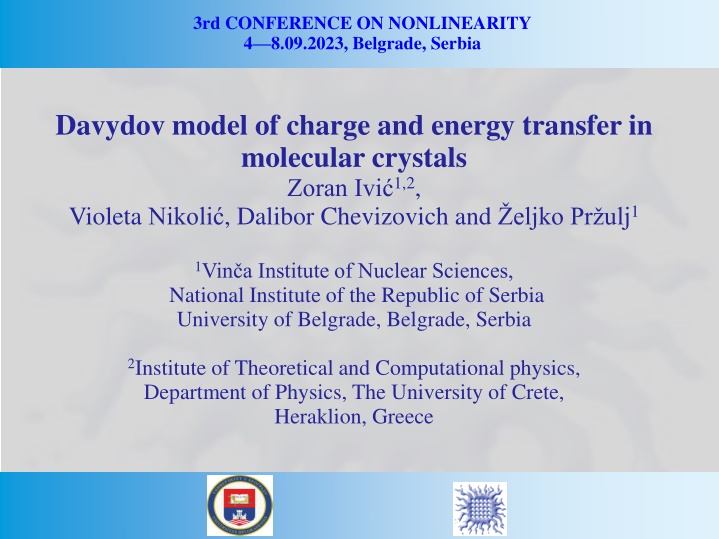
Energy Transfer Mechanisms in Molecular Crystals: Insights from Davydov Model
Explore the Davydov model's implications on charge and energy transfer in molecular crystals, crisis resolution in bioenergetics, band mechanism in molecular bridges, and the exciton vs. soliton model. Discover how these mechanisms provide high efficiency energy transfer and stability through interactions with lattice modes, dipole-dipole couplings, and phonon-assisted quasiparticle stabilization. Dive into the physical, formal, and topological aspects of energy lowering and lattice deformation in achieving stabilization.
Download Presentation

Please find below an Image/Link to download the presentation.
The content on the website is provided AS IS for your information and personal use only. It may not be sold, licensed, or shared on other websites without obtaining consent from the author. If you encounter any issues during the download, it is possible that the publisher has removed the file from their server.
You are allowed to download the files provided on this website for personal or commercial use, subject to the condition that they are used lawfully. All files are the property of their respective owners.
The content on the website is provided AS IS for your information and personal use only. It may not be sold, licensed, or shared on other websites without obtaining consent from the author.
E N D
Presentation Transcript
3rd CONFERENCE ON NONLINEARITY 4 8.09.2023, Belgrade, Serbia Davydov model of charge and energy transfer in molecular crystals Zoran Ivi 1,2, Violeta Nikoli , Dalibor Chevizovich and eljko Pr ulj1 1Vin a Institute of Nuclear Sciences, National Institute of the Republic of Serbia University of Belgrade, Belgrade, Serbia 2Institute of Theoretical and Computational physics, Department of Physics, The University of Crete, Heraklion, Greece
Crisis in Bioenergetics Davydov model: Resolution of crisis in bioenergetics Crisis in bioenergetics Counterintuitive extremely high efficiency of long-distance energy transfer Energy production-hydrolysis Of ATP Exploitation Efficiency 98% HOW Which mechanisms provide so high efficiency
Molecular bridges Band mechanism: Consideration of the problem through the prism of Quantum theory of solids Simplified model 1d molecular crystal Translational invariance of biological macromolecules periodic arrangement of peptide groups mediator helix Dipole-dipole coupling between neighboring provides energy transfer Energy released in ATP hydrolysis J Inter PG dipole-dipole coupling Resonant transfer of from Donor to PG group and its collectivization - exciton
Exciton vs soliton model Exciton are unstable and quickly spread and decay Davydov: proposal of soliton model Stabilization of quasiparticle state through the interaction with lattice modes: trapping by local deformation Small polaron Binding energy Davydov soliton-bound state of local deformation of lattice and excitation Phonon-assisted quasiparticle stabilization The main obstacle turned into an advantage
Stabilization Physical: energy lowering and formation of BS Formal: IST arguments Topological: kink-like form of lattice deformation +??+1+h.c) + ? ??? +??(un+1-un-1) + Hlatt +?? ? ?(?? ? = ??? | > = |? > | ?>, semiclassical analysis results in NLSE 2 2??2 ?| |2 ? = ? 2??? 1? ? 2??? ? ??(x-x0-vt) ??(x-x0-vt), ?~ ? = IST arguments: Infinite number of integrals of motion No mixing different branches of NLSE spectrum-soliton and continuum Topological: kink-like soliton lattice deformation are topologically stable
Controversies Pointless Criticism: The consistency of the method (DA) with quantum mechanics Are DS-solutions true solutions of the Schr dinger equation for DM Of course, they are not but when some approximative solutions may pretend to exactness Less pointless: when DST offers a physically reliable picture of some physical phenomenon Resolution Discussion on the validity of DST within system parameter space
ST basics quasi-particles in the CM form various types ST states polaron - small, large, magnetic, acoustic, Each of which appears for particular values of system parameters Quasi-particle bandwidth, characteristic phonon frequency: 2J, 0 and ??= ??0 Their mutual ratio determines The type of ST state and The choice of the mathematical tool Approximation 4?2 2 SP binding energy Two well-known limits Adiabatic 2J>> 0 large polaron and semiclassical approximation
DST vs ST DS-must be adiabatic ST state <= semiclassical analysis Also strong coupling Eb>> 0 so that phonons can not excite QP from the well Large radius Basic parameters and their ratios B=2J/ 0 adiabatic ratio S=Eb/ 0 coupling constant l ~B/S dimensionless length Conditions of existence and validity of the physical picture B>>1 S>>1 B>>S
Thermal stability What Davydov oversaw? NLSE was derived by taking only particular solutions for lattice modes. Accounting for fluctuation homogeneous part yields perturbed - STOCHASTIC NLSE 2 2??2 ?| |2 + ?(?,?) ? ?,? ?(? ,? ) = ???? ? = ?(? ? + ??(? ? )) ?= 1 Which is not integrable implying soliton instability Within the IST perturbation theory DS lifetime is estimated as ? ~2.2 10 2? ? ?? ??
Conclusions -helix DNA & conducting polymers B ~ 0.1 S ~ 0.17 B ~100 S >> 1 DS-large polaron may be relevant for transfer processes in DNA and conducting polymers In -helix small-any-adiabatic polaron
